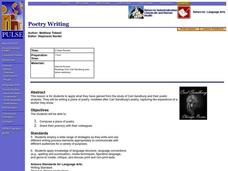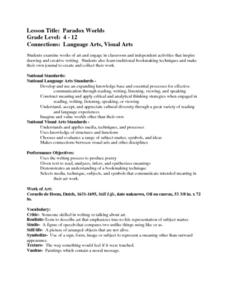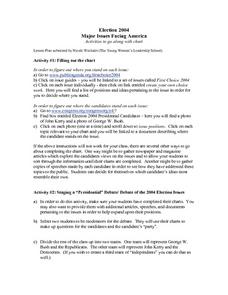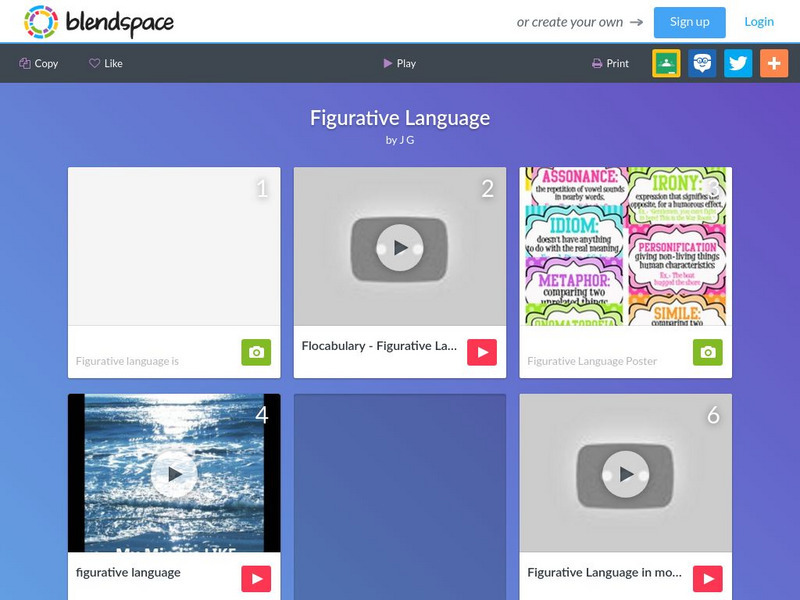Curated OER
The Practice Interview
Students study the interview process by interviewing each other in pairs using a name game. They formulate and ask effective interview questions and practice interviewing skills. They invite a guest to their classroom or go outside the...
Curated OER
Express Yourself!
Students practice the strategy of reading fluently with expression with the story "Who took the Cookies from the Cookie Jar?" They read and reread the story utilizing different strategies when stuck on a word. Students practice whole...
Curated OER
Poetry Writing
Students compose a piece of poetry modeled after the poetry of Carl Sandburg and share their poem(s) with their colleagues. They use a cluster diagram to organize their thoughts and brainstorm their ideas.
Curated OER
Poetry In Motion
Fourth graders read and analyze poetry and examine the process of writing poetry. They read and analyze the poem "From a Railway Carriage" by Robert Louis Stevenson, and answer comprehension questions. They identify the similes,...
Curated OER
Brain Drain
In this brain drain worksheet, students create a product name for a new product on the market, identify why the product is special and decide the target audience. Students then design a magazine, radio, or TV. advert for their product....
Curated OER
Paradox Worlds
Students view and analyze "Still Life," by Cornelis de Heem. They answer discussion questions about the painting, write similes, discuss symbolism, create a still life sketch, and create a paint box poem.
Curated OER
I Am Who We Are
Students explore the concept of philanthropy and identify specific acts of philanthropy that have affected them personally. They plan and carry out acts of philanthropy focusing on giving back to their community.
Curated OER
To Be Or Not To Be: Reading With Expression
Students observe and demonstrate a variety of strategies for reading with expression. They listen to the teacher read "Jabberwocky" by Lewis Carrol with and without expression, and discuss the differences. In small groups they...
Curated OER
It's Time to Open Wide for O
Students recognize the short vowel o in written and spoken language. Through listening and decoding activities, they discriminate the vowel sound /o/ from other phonemes. Students match the phoneme and letter in words they read on index...
Curated OER
Most Wanted Villians
Students review the characteristics of various characters in fairytales. As a class, they review the story details and create a concept map using a software program. They create their own wanted poster of the villians in the fairytale to...
Curated OER
Method for Teaching the Blending of Sounds: Train Technique
Students explore the blending of individual sounds to make words and, using visuals and manipulatives, equate this process to the hooking up of railroad cars to make a train. They link individual letters/sounds to make short words.
Curated OER
Major Issues Facing America
High schoolers continue to examine the issues of the 2004 presidential election. Using the internet, they discover where they stand on each issue and where each candidate stands on the issues as well. In groups, they participate in a...
Curated OER
Sorting the Loyalist Documents
Middle schoolers organize the Canadian Loyalist primary source documents and add more information to their primary source document concept maps.
Curated OER
Creating Storyboards for Younger Students
Students create electronic storyboards for younger children about a nearby refuge and lake. After interviewing the younger students about their impressions of the lake, they use Powerpoint to make the storyboard, including the interview,...
Texas Education Agency
Texas Gateway: Imagery and Figurative Language (Grade 6)
This lesson focuses on the use of imagery and figurative language in writing to aid understanding and create images in the mind.
National Endowment for the Humanities
Neh: Edsit Ement: Their Eyes Were Watching God: Folk Speech, Figurative Language
For this lesson plan, students will consider Their Eyes Were Watching God: Folk Speech and Figurative Language. Worksheets and other supporting materials can be found under the Resources tab. This lesson provides students with an...
ReadWriteThink
Read Write Think: Figurative Language Awards Ceremony
Contains plans for five to seven lessons that teach about figurative language like similes, metaphors, and personification by asking students to write award acceptance speeches that incorporate them. In addition to objectives and...
ReadWriteThink
Read Write Think: Finding Figurative Language in the Phantom Tollbooth
Contains plans for four lessons that use The Phantom Tollbooth by Norton Juster to teach about figurative language. In addition to objectives and standards, this instructional plan contains links to handouts and to sites used in the...
TES Global
Blendspace: Figurative Language & Tone
A twelve-part learning module with links to texts, videos, and websites on figurative language and tone.
Writing Fix
Writing Fix: An I Pod Inspired Poetry Lesson: Paradox Poetry
Jack Johnson's "Inaudible Melodies" creates an interesting paradox of how society perceives itself versus the reality of how society really behaves. After listening to a second song using paradox in order to further understand the...
TES Global
Blendspace: Figurative Language
A twelve-part learning module on figurative language including links to images, videos, a song, and a game to help students learn.
ClassFlow
Class Flow: Figurative Language Review
[Free Registration/Login Required] This lesson helps students understand figurative language.
Texas Education Agency
Texas Gateway: Irony, Sarcasm, and Paradox (English Ii Reading)
[Accessible by TX Educators. Free Registration/Login Required] In this lesson, you will learn to evaluate the role of irony, paradox, and sarcasm in literary nonfiction such as speeches and essays. It includes the definitions and...
Georgia Department of Education
Ga Virtual Learning: Descriptive Writing: What Is Descriptive Writing?
This lesson focuses on what descriptive writing including defining it and discussing the characteristics. It includes links to several websites about descriptive writing including the Discovery Education Video: "Literature for Children:...

























